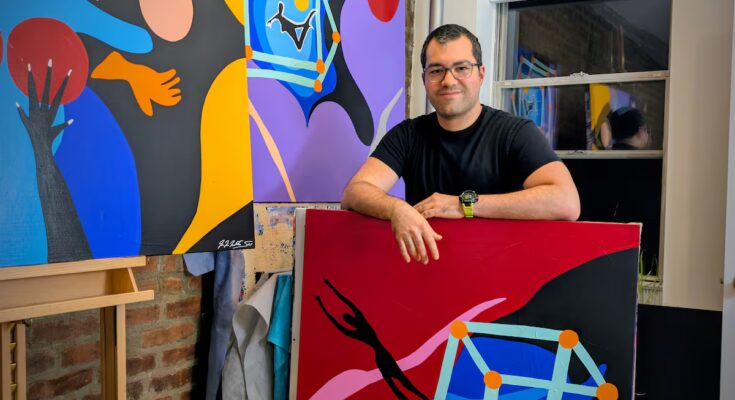In January last year, as the United States welcomed back the Trump administration, Venezuelan artist Juan Luis Landaeta began to feel as if the walls were closing in around him. The president had announced his decision to cancel Temporary Protected Status (TPS) for thousands of Venezuelan migrants, starting November 7, and Landaeta remembers feeling trapped, almost petrified, in a transparent cage the size of the United States. This cage allowed him to move freely, even to see what was outside, but it made him feel like a prisoner.
“For the first time in my entire life, I realized that I’m the one that’s being threatened,” acknowledges Landaeta, 37, in an interview in his home and studio in the West Harlem neighborhood of New York City. “My passport has expired, Venezuela doesn’t have a consulate or embassy here, my family is far away and many of my relatives have TPS. I feel trapped because I can’t travel, I can’t move freely. But it’s also a very effective type of confinement because I can go out on the street and leave the state, and yet I still feel trapped.”
Trying to express what he felt, he turned to the canvas and what seemed vague began to take shape Confinement is a vocabularyhis new exhibition opening at the UNAM Chicago campus starting November 13th. In it, Landaeta explores, using silhouettes and vibrant colors characteristic of pop culture, scenes that portray the threats faced by migrants in the United States. “I decided to talk about myself and what was happening to me,” he says.
His work shows a dissonance between color and the scenes depicted. The pieces in this collection are a compendium of bodies threatened by sharp objects, hammered by claws or enclosed in large glass boxes. They are, however, painted in colors like the pink of Princess Aurora’s dress Sleeping Beautythe blue of Superman or the red of Elmo from Sesame Street. For Landaeta this is not a contradiction, but a conscious decision.
Just as chemical-tasting pills are encased in a cellulose capsule to mask the unpleasant taste so that people can ingest them and, in doing so, relieve pain, cure an illness, or heal wounds, Landaeta chooses bright colors to address the threats faced by migrants, especially Venezuelans, at the hands of the Trump administration. “If pop art and its colors are unanimously considered superficial, this is attractive to me,” says Landaeta. “After all, color simply exists; it’s up to you to interpret it.”
Since January, under Trump’s direction, Immigration and Customs Enforcement (ICE) has conducted a campaign of mass deportations, including arrests at courthouses where migrants go for routine immigration status appointments, as well as large-scale raids. Republican administration officials and Trump himself insisted on the lie repeated by the then-Republican candidate in the months leading up to the 2024 election: that immigration would contribute to rising crime in the United States and that Venezuelan immigrants, in particular, should be expelled from the country because of their alleged ties to the Tren de Aragua criminal gang.
Landaeta portrays this reality in his work with silhouettes that suggest bodies. If he omits elements such as hair, eyes or clothes it is because this allows him to convey his message without distractions. Sharp objects that threaten these bodies rarely touch them; rather, they are viewed as a way to exert control. “I felt targeted by everything that was happening and thought, ‘What do you use to target? Arrows.’ Then, trying to draw an arrow, a fang came out,” explains the artist.
Landaeta emigrated to New York in 2013, after the death of Hugo Chávez and Nicolás Maduro assumed the presidency of Venezuela. That year, the opposition called for massive protests and there was increased government pressure on human rights defenders, along with a consolidation of the courts in favor of the executive branch. At the time, Landaeta was working as a lawyer in Caracas and decided to apply to universities abroad to leave Venezuela. When he finally received a scholarship to New York University to earn a master’s degree in creative writing in Spanish, he left his country. At that point painting was just a hobby.
Although Venezuela’s humanitarian and economic crisis was already erupting in 2013, not so many Venezuelans had yet arrived in New York. At the time there were about 9,000, according to city data. For comparison: In the last three years alone, since the surge in immigration to New York in 2022, an estimated half of the more than 200,000 migrants arriving in the Big Apple are Venezuelans.
After arriving in New York, Landaeta, like most Latinos in the United States seeking familiarity with their communities in diaspora or exile, began to connect with other Venezuelans in the city and, over time, formed a close friendship with contemporary artist Jacobo Borges. “I didn’t study art, but I had Jacobo,” he says. “When he heard about me I was a writer, an interviewer at best. But I began to understand the formal and technical terms; that’s when I understood the things I had intuited and became a visual artist.”
The trip to New York not only gave him the opportunity to become a visual artist and meet great figures of the Venezuelan artistic tradition, but also reconnected him to Venezuela: “New York brought me closer to myself, to the fact of being Venezuelan. In New York I listened to Venezuelan music that I had never heard in Venezuela. Popular songs, master musicians, singers from the coast, incredible people that I discovered in the East Village.”
For Landaeta, the exhibition Confinement is a vocabulary it was an opportunity to find the language that best suits his experience as an exile. For a long time he felt compelled to tell stories about migration, but his first collections were very far from this and focused on abstract art. “I was worried, but my artwork didn’t do it very well because it was definitely not figurative. I wanted to say something and the first thing I had to do was find my vocabulary,” explains Landaeta.
It is a unique and very personal language, but one that encourages reflection, allowing the audience to come to their own conclusions and imagine other possibilities. “Everything in his work is distorted, and this is an invitation to connect with others through their experience, their perspective and their bodies,” says the exhibition’s curator, Ionit Behar.
“For me, imagination is the ability to represent new realities that did not exist before,” says Landaeta. For the artist, if the oppressor, whether Trump himself or his government, can stop people from imagining, the battle will be lost: “There’s something there that’s not just about empowerment; it’s about getting closer to our common humanity.”
Registration for our weekly newsletter to get more English-language news coverage from EL PAÍS USA Edition



